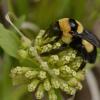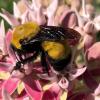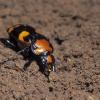
The Carson Wandering Skipper is currently known from only two populations, one in Washoe County, Nevada, and one in Lassen County, California. The subspecies is found in grassland habitats on alkaline substrates. The sites where viable populations are still found are at risk because of livestock grazing, off- road vehicle activity, encroaching development, gas and geothermal development, changes in the water table, pesticide drift, and non-native plant invasion.
Taxonomic Status
(Lepidoptera: Hesperiidae: Hesperiinae)
Pseudocopaeodes eunus obscurus Austin and J. Emmel, 1998.
The dorsal side of the wings is tawny orange except for a narrow uniform border and black veins near the border at the outer edge of the wing. The underside of the hind wing is pale creamy orange with two creamy rays extending from the base of the wing to its margin, and there may be dusky suffusions along the wing veins.
Males tend to average 13.1 millimeters (mm) (0.52 inches (in)) in size (ranging from 12.0 to 13.9 mm (0.47 to 0.55 in)) (size is forewing length from base to apex). Females average 14.7 mm (0.58 in) in size, and range from 13.4 to 15.6 mm (0.53 to 0.61 in) from forewing base to apex. The female’s dorsal (upper) surface is similar to the male’s, but with heavier dusting on the discal area of the hindwing. The female’s ventral surface is similar in appearance to that of the male.
The Carson Wandering Skipper can be distinguished from the other subspecies of P. eunus (the Alkali Skipper) by a combination of several characteristics. It is duller overall than other eunus subspecies, with the tawny orange ground color interrupted by thick black coloring along the outer margin of the wings and, especially on the ventral surface, along the veins.
Carson Wandering Skipper females lay their cream-colored eggs on salt grass (Distichlis spicata), the larval host plant for the subspecies.
Prior to European settlement, a population of P. eunus obscurus probably occurred from Carson Hot Springs to the Carson River. The Carson Wandering Skipper is currently known from only two populations, one in Washoe County, Nevada, and one in Lassen County, California. The subspecies is found in grassland habitats on alkaline substrates.
This is a common plant species in the saltbush- greasewood community of the intermountain west. Salt grass usually occurs where the water table is high enough to keep its roots saturated for most of the year.
Xerces Society Red List Status: Critically Imperiled
Other Rankings:
Canada – Species at Risk Act: N/A
Canada – provincial status: N/A
Mexico: N/A
USA – Endangered Species Act: Endangered
USA – state status: None
NatureServe: G3G4T1
IUCN Red List: N/A
In the late 1990’s, P. eunus obscurus could be found at three locations: (1) near Carson City, Nevada, (2) at Winnemucca Ranch in Washoe County, Nevada, and (3) near Honey Lake in Lassen County, California. At the first of these, the butterfly appears to have been extirpated due to development and a misguided attempt at wetland restoration. The second, which is currently occupied by the butterfly, includes both BLM and private land. The third—actually a collection of small, closely associated sites—is on public (California Department of Fish and Game) and private land; it may offer the better opportunity for immediate conservation action.
The Carson Wandering Skipper was listed as a Federal Endangered Species on August 7, 2002 (Federal Register 67:51116).
Recovery Plan (ESA): None.
Critical Habitat (ESA): None designated.
Neither California nor Nevada include insects in their endangered species legislation, so despite the precarious situation of Carson Wandering Skipper populations, there is no state protection.
The sites where viable populations are still found are at risk because of livestock grazing, off-road vehicle activity, encroaching development, gas and geothermal development, changes in the water table, pesticide drift, and non-native plant invasion.
Adequate habitat containing the necessary larval host plants must be secured for this butterfly. Much of the existing populations are on land owned by the Bureau of Land Management or the California Department of Fish and Game. In addition, there is an effort to purchase the land that holds the only population on private land by the BLM. Surveys should be conducted to confirm size of existing populations and to search potential sites for additional populations. Additional studies of habitat needs would be valuable.
Brussard, P. F., B. Niell, and G. T. Austin. 1999. Report on the Distribution, Genetics and Conservation Status of the Carson Wandering Skipper, Pseudocopaeodes eunus obscurus. A Report to the Nevada Department of Transportation.
Brussard, P. F. 2000. Draft Conservation Plan for the Carson Skipper. A Report to the Nevada Department of Transportation.
Profile prepared by Scott Hoffman Black and Mace Vaughan, The Xerces Society for Invertebrate Conservation.
Citation
Black, S. H., and D. M. Vaughan. 2005. Species Profile: Pseudocopaeodes eunus obscurus. In Shepherd, M. D., D. M. Vaughan, and S. H. Black (Eds). Red List of Pollinator Insects of North America. CD-ROM Version 1 (May 2005). Portland, OR: The Xerces Society for Invertebrate Conservation.





